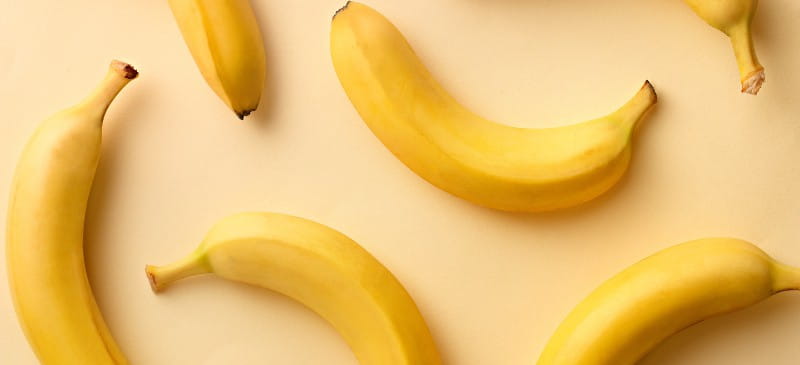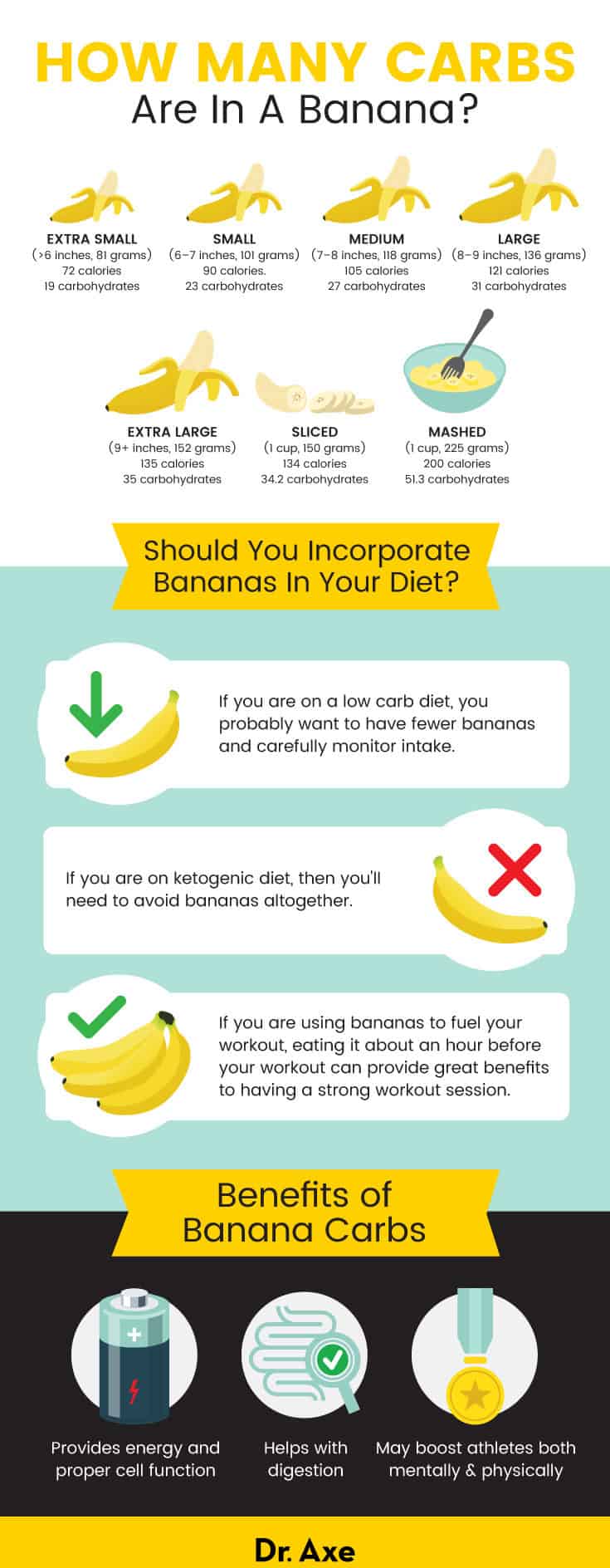The Carb Count of Bananas
How Many Calories and Carbs in a Banana Are There?
Bananas are one of the most popular fruits on the planet, but have you ever wondered how many carbs in a banana there are?
Bananas come in their own yellow package, making them easy to take with you on the go, and banana nutrition contains several important vitamins and minerals, in addition to carbohydrates, which are some of the reasons bananas are so popular among athletes.
However, in order to get to their carb state, they must ripen. Once they do that, you may wonder how many carbs in a banana are there.
A green banana contains more starch, but as it ripens, it converts to sugar — therefore offering carbohydrates. Bananas are also easy on the stomach — another reason they’re a main source of fuel for athletes.
All bananas are not created equal. Nutritionally, they’re about the same, but in terms of calories, it depends on the size of the banana.
Keep reading to find out how many carbs in a banana and how many calories in a banana there are.

How Many Carbs In a Banana?
An average-sized banana is usually about 100 calories, but like all foods, portions matter. Here is a banana chart to get a better idea of how many calories and how many carbs in a banana there are: (1)
- Extra small (less than 6 inches, 81 grams): 72 calories, 19 carbohydrates
- Small (6–7 inches, 101 grams): 90 calories, 23 carbohydrates
- Medium (7–8 inches, 118 grams): 105 calories, 27 carbohydrates
- Large (8–9 inches, 136 grams): 121 calories, 31 carbohydrates
- Extra large (9 inches or longer, 152 grams): 135 calories, 35 carbohydrates
- Sliced (1 cup, 150 grams): 134 calories, 34.2 carbohydrates
- Mashed (1 cup, 225 grams): 200 calories, 51.3 carbohydrates
A part of the Musaceae family, the banana plant grows 10 to 26 feet tall. Bananas grow in clusters from 50 to 150 bananas per giant cluster.
Then, each cluster contains smaller groups called bunches. Each bunch is known as “hands” and may contain anywhere from 10 to 25 bananas. (2)
The carbohydrates in bananas are not unlike other carbohydrates; the difference lies in the fiber. While the banana has plenty of carbohydrates — in fact, more than an orange — it also contains fiber and starch, which can make you feel fuller longer since carbs digest far faster and promote satiety.
Fiber helps slow the release of the carbs into the bloodstream.
However, it’s important to note that bananas can have a greater effect on blood sugar levels than oranges or strawberries. What that means is that they have more carbs and, ultimately, a higher glycemic index and glycemic load.
Glycemic index and glycemic load measure blood sugar levels, which can be really important to diabetics. Still, many consider the banana a smart choice for keeping blood sugar in good order. (3)
Bananas are also popular with anyone who is on a carb cycling diet, aka when you eat more carbs on certain days. So how many grams of carbs per day do you need, and how many carbs in a banana do you want to consume?
If you’re active, about 40 percent of your calories should come from carbs, another 30 percent from protein and another 30 percent from fat in general.
In general, how many grams of carbs per day you should consume is probably going to be in between 500 and 800 calories from carbohydrates, and that’s typically about 150 to 200 grams of carbohydrates per day — 200 is an upper amount and goes as low as 120, which may be ideal for many trying to trim down.
Bananas are a good source to get some of these carbs, with one to two a day depending on the size of the banana and how many carbs you get from other sources.
Benefits of Banana Carbs
1. Provide Energy and Proper Cell Function
Even with the popular low-carb diets, carbohydrates are still the main source of fuel, aka energy, for the body. Let’s dig in to how this works.
When you eat, your body takes the food and breaks it down into sugars and starches so it can be absorbed into the bloodstream.
When this happens, the sugars and starches are converted into glucose. This is also known as blood sugar.
This is key since glucose is needed for your body to function properly. It keeps the brain sharp while offering energy for everything from day-to-day tasks to workouts.
Furthermore, have you heard of adenosine triphosphate, or ATP? ATP is a key source of fuel found within the cells.
ATP is formed through a natural chemical reaction process after digestion and can be created from carbohydrates, proteins and fats. But what’s important is that the cells use ATP to fuel proper cellular function.
A number of foods from both plant and animal sources provide ATP, and bananas are one of them. Bananas have plant cells that keep ATP in reserve, so when you consume a banana, it’s converted into glucose, then used to make ATP when required by the body. (4)

2. Help with Digestion
As I noted above, bananas are actually considered low in their glycemic index (GI) value. The GI measures the impact of a food on the blood sugar in the body.
So how can a super-sweet banana be OK in the category of glycemic index? It’s in the fiber.
Fiber helps keep the digestion process at a speed that our bodies can tolerate. This allows the conversion of carbs to simple sugars to occur at a pace that provides a much easier digestion process.
Furthermore, bananas contain pectins. Pectin is a rather complicated type of fiber — some pectin is water-soluble and some are not.
During the ripening process, the water-soluble pectins increase, causing the banana to soften as it ripens. This process increases the level of fructose, which helps stabilize the rate of “carbohydrate digestion,” another reason it’s best to eat ripe bananas versus those green ones.
Taking it a bit further, the fructooligosaccharides (FOS) in bananas add to a smoother digestive process. FOS are fructose-filled carbs that are usually not broken down by the enzymes found in the digestive system.
They actually move on by making their way to the lower intestine and eventually are metabolized by good bacteria.
This is why it’s critical to heal a leaky gut. A leaky gut may have trouble with this and other digestive processes.
Keeping the good bacteria, such as Bifidobacteria, in the lower intestine can really benefit overall digestive health.
3. May Help Give Athletes a Boost Mentally and Physically
Research was conducted on ultra runners to understand what they preferred to eat before, during and after an endurance run. It seems that during the race, bananas were definitely a preference, probably for both the energy from glucose and the ease of digestion, though the reasons were not indicated in the study. (5)
This is because bananas and other fruit are productivity-boosting foods.
Another study out of Cornell University was conducted with athletes performing 90 minutes of running followed by 90 minutes of cycling or cycling to exhaustion. Athletes were given a placebo, a banana blend or solid banana.
The study indicated that the solid banana was very effective in enhancing endurance exercise performance. (6)
The Journal of the International Society of Sports Nutrition studied young gymnasts, ages 12–14, who were given carbohydrates to evaluate performance in fatigued athletes. Those who we given carbs were more focused and had fewer falls during their performance routines. (7)
It’s clear that bananas are a great source of fuel for athletes or anyone performing physical activity, but it’s best to consume them an hour or two prior to the physical event. The reason for this is that eating just before can diminish performance and make you feel a little uncomfortable, since the body will direct blood flow to the stomach for digestion upon consumption. (8)
Banana vs. Plantain
In all this banana talk, you may be wondering about the differences in plantain carbs vs. banana carbs and how many carbs are in a plantain vs. how many carbs in a banana there are. So let’s set the record straight by learning a little bit about the plantain.
It makes sense that plantains are in the same family as bananas since they look a good bit alike. However, plantains contain more starch than bananas.
In most cases, plantains are eaten cooked with the riper versions found in dessert dishes. (9)
Here’s how to the two match up in terms of carbs:
How many carbs in a banana + calories (raw):
- Sliced (1 cup, 150 grams): 134 calories, 34.2 carbohydrates
- Mashed (1 cup, 225 grams): 200 calories, 51.3 carbohydrates
How many carbs in a plantain + calories (cooked): (10)
- Sliced (1 cup, 154 grams): 179 calories, 48 carbohydrates
- Mashed (1 cup, 200 grams): 232 calories, 62.3 carbohydrates
How to Incorporate Bananas in Your Diet
How many bananas you eat per day or per week depends on lots of factors.
If you’re on a low-carb diet, you probably want to have fewer bananas and carefully monitor intake. If you’re using bananas to fuel your workout, eating one about an hour before your workout can provide great benefits to having a strong workout session.
Another factor that needs to be considered is the amount of potassium found in bananas. Potassium is a required nutrient for the body, but some researchers suggest that too much potassium can cause problems for someone with kidney disease.
However, according to a report by the BBC, a healthy person would have a hard time overdosing on bananas: “You would probably need around 400 bananas a day to build up the kind of potassium levels that would cause your heart to stop beating… Bananas are not dangerous — and in fact they are, and always have been, very good for you.” (11)
Like most anything in life, moderation is key, but consider using your banana consumption to fuel your body for a sharp mind and a great workout. Having one of two bananas per day is fine, but if that’s more than you care for, just have two or three a week combined with a balanced diet to ensure that your body makes the most of the nutritional benefits they contain.
Lower-Carb Banana Recipes
Bananas can be eaten alone, as part of a smoothie, in your morning overnight oats or chia pudding, in baked goods, frozen — the ideas are endless. Here are some lower-carb banana recipes you can try:
- Chocolate Banana Nut Smoothie
- Gluten-Free Banana Bread
- Banana Egg Paleo Pancake
Risks and Side Effects
Bananas are a great source of energy and provide numerous other benefits as well. If you have an allergic reaction to bananas, stop eating them immediately and consult your doctor.
We are not aware of any health risks associated with bananas, but if too much sugar causes you headaches or weight gain, or if you have reactions to potassium, consume in moderation and/or consult a physician.
Final Thoughts
- Bananas are one of the easiest and healthiest foods for on-the-go and can add nutrition to any recipe.
- Wondering how many carbs in a banana there are? Naturally, how many carbs in a banana depends on the size.
- In addition to the health benefits this nutritional self-contained powerhouse offers, the carbohydrates are a great source of energy while being easy to digest. Consider having a few bananas a week as part of your routine.





Leave a comment